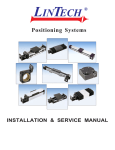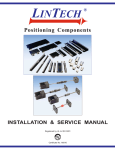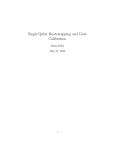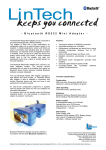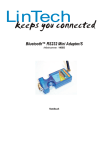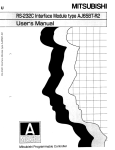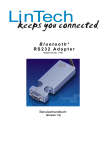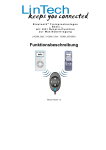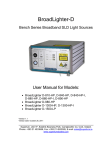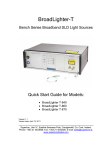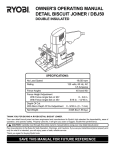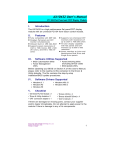Download Components Service Manual
Transcript
LINTECH ® Positioning Components INSTALLATION & SERVICE MANUAL Welcome to LINTECH ® Our local technical support group consists of Automation Specialists located throughout the World. These Automation Specialists are experienced in the use of electronic and mechanical motion control products. They are well trained on the performance capabilities of LINTECH positioning components. LINTECH is constantly designing new products and improving upon the many options available with our standard products. Whether it is a standard or custom positioning system required, visit our website, call, or e-mail us. We look forward to hearing from you. Visit our website, or call us for the location of the nearest Automation Specialist in your area: LINTECH ® For over 43 years LINTECH has designed, engineered, and manufactured mechanical motion solutions for use in a wide range of applications. Whether it is a standard positioning component or a custom positioning system, LINTECH takes great pride in manufacturing a quality product. At LINTECH we are proud to provide the motion control user with this general product guide. It was developed to assist you with acquiring the general knowledge of what LINTECH has to offer. You can find complete details on all LINTECH products via our website. Toll Free: Phone: Fax: 1845 Enterprise Way Monrovia, CA. 91016 (800) 435 - 7494 (626) 358 - 0110 (626) 303 - 2035 Web Site: E-Mail: www.LintechMotion.com [email protected] Depending on the requirements, standard positioning components can often be assembled and shipped in less than 2 weeks. Custom positioning assemblies require a different approach. We evaluate your special application, use our many years of experience to guide you, and then manufacture a quality product designed to meet your performance specifications. LINTECH's technical support consists of a well trained inside customer service department, an experienced application engineering staff, and a versatile machining facility. version: 01/2014 Copyright© 2014 LINTECH ® www.LintechMotion.com LINTECH ® Warranty & Returns Service Manual Overview Thank you for purchasing a LINTECH positioning component. This manual provides you with important information about your LINTECH product. It also points out some precautions which should be taken to ensure proper operation, and the longest possible life of your LINTECH component. LINTECH manufactures both standard and custom positioning components which are used in a wide variety of applications and industries. For a full description and details on your component, please refer to the proper LINTECH Positioning Component catalog or your original quotation if a custom assembly was purchased. Technical Assistance Please do not hesitate to call LINTECH with any questions you have. You may contact the LINTECH Automation Specialist in your area for local help, visit our web site, or call the factory direct. If, for any reason, you need to contact LINTECH, or an Automation Specialist, please have ready the Model & Serial numbers of your positioning component, as this may speed the process of answering your question. LINTECH 1845 Enterprise Way Monrovia, CA 91016 Toll Free: (800) 435 - 7494 Phone: (626) 358 - 0110 Fax: (626) 303 - 2035 Web Site: www.LintechMotion.com E-mail: [email protected] Standard Warranty Policy All LINTECH positioning components are guaranteed to be free from defects in material and workmanship, under normal use, for a period of one year after date of shipment. This warranty covers the repair or replacement of a product when it is sent prepaid to LINTECH. LINTECH does not assume liability for installation, abuse, alteration, insufficient application data provided for a design, or misuse of any positioning component. Products furnished by LINTECH, but not manufactured by LINTECH (motors, gearheads, encoders, amplifiers, etc....), are subject to the manufacturers standard warranty terms and conditions. Return Policy Any product requiring a return to LINTECH (for warranty or non-warranty repair) requires pre-approval from the factory prior to shipment. Contact the customer service department at (800) 435-7494 in order to obtain a RMA (Return Materials Authorization) number. At that time, please have your system Model & Serial numbers available, along with the reason for the return. The RMA number should be clearly marked on the returned package label and your packing list, or shipping document. Return product freight prepaid in its original package, or one with comparable protection. LINTECH will not accept return shipments sent freight collect. Product damage incurred during return shipment, from poor packaging, will not be warranted by LINTECH. Keeping original packing materials is recommended until initial inspection & testing is completed. Dimensions and Product Changes Published dimensions shown in the Positioning Component catalogs are known to be accurate at the time of printing. LINTECH shall not be held liable, under any circumstances, for any wrongly documented dimension or specification. Changes in design are made whenever LINTECH believes its product will improve by the change. No obligation to incorporate these changes in units manufactured prior to a change, will be assumed. LINTECH ® www.LintechMotion.com 1 Ball Screw Assemblies Service Manual Handling - Ball Screw Assemblies Every LINTECH Ball Screw Assembly must be handled carefully so as not to introduce "bending" of the screw thread, scratching of the screw thread, or nicking of the screw thread. Any of the above will result in unexpected operation of the Ball Screw Assembly. Independent of the assembly length, the Ball Screw assembly should NEVER be held in the middle only, since the unsupported housing weight and handling of the unit could bend the screw thread. When unpacking the assembly, support the unit on each end when moving and installing the unit. WARNING - Improper handling of a Ball Screw Assembly will void the warranty of your assembly. Installation Tips Precise alignment of a LINTECH Ball Screw Assembly with the linear bearings & rail, mounting surface, and carriage surface of an overall mechanical assembly is critical to ensure proper operation, and to obtain the required life of the system per the catalog ratings. The exact parallelism, and tolerances required will depend largely upon the bearing & rail type (square, round, roller, etc.), and any mechanical alignment compensation that the machine designer incorporates (i.e. slotted mounting holes, floating keyways, etc.) in the mechanical assembly. Also, examine the surfaces of the nut adapter flange (carriage plate) & housings. These mounting surfaces should be flat, smooth, and unpainted. Mounting and Alignment Use of a dial indicator or a laser alignment device is required for this procedure. Without either, it will be impossible to define exact parallelism and height alignment of the assembly. WARNING - Improper alignment of a Ball Screw Assembly can cause excessive noise, binding, vibration, rough operation and outright failure after only a few operating cycles. Improper alignment will void the warranty of your assembly. It is extremely important that the ball nut is ONLY loaded axially (with no radial loading or side to side loading). The ball nut is rated for a "pure" thrust load. If a dial indicator is not used, it will be difficult to measure any height variances. Height variances will lead to rough/noisy operation, and premature (or immediate) failure. Use of a Dial Indicater is Highly Recomended Mounting Surface To assist in proper installation, please follow the general step by step procedure below and on the next page. Before proceeding, please note that the Ball Screw Assembly should be lubricated with an operational oil/grease prior to moving the attached nut. Step 1: Place the Ball Screw Assembly on your mounting surface and attach the support housing mounting screws on both ends. DO NOT FULLY tighten "only finger tighten" these screws during this step. Step 2: Precisely check the system parallelism over the entire length, of your linear bearing & rails to the screw shaft. Adjust the Ball Screw Assembly accordingly. Linear Bearing Rail Check Parallelism Check Parallelism Linear Bearing Rail 2 www.LintechMotion.com LINTECH ® Ball Screw Assemblies Service Manual Mounting and Alignment Step 3: Without the NUT Bracket attached to the Carriage (Load) plate - Preceisely measure from the mounting surface to the top of the screw thread near the motor mount housing. Step 4: Without the NUT Bracket attached to the Carriage (Load) plate - Preceisely measure from the mounting surface to the top of the screw thread near the housing opposite the motor mount end. Step 3 Step 4 Mounting Surface Mounting Surface Step 5: Compare the values in Step 3 and Step 4 above. Shim the support housings accordingly to obtain the same height values. Repeat steps 3 & 4 above until the same heights are obtained. Step 6: With NO SYSTEM LOAD on the Carriage (Load) plate - Insert the mounting screws from your carriage plate (which should be supported by the linear bearing & rail system) into the NUT bracket. DO NOT FULLY tighten "only finger tighten" these screws during this step. Shim accordingly to correct for gaps between the carriage plate and NUT bracket. Slowly move the Carriage & nut bracket to the drive support housing (motor mount end) and preceisely measure from the mounting surface to the top of the nut bracket. Step 7: With NO SYSTEM LOAD on the Carriage (Load) plate - Slowly move the Carriage & nut bracket to the opposite support housing and preceisely measure from the mounting surface to the top of the nut bracket. Step 6 Step 7 Carriage Plate Carriage Plate Mounting Surface Mounting Surface Step 8: Compare the values in Step 6 and Step 7 above. Shim the support housings accordingly to obtain the same values. Repeat steps 3 & 4 above until the same heights are obtained. Step 9: Slowly slide the carriage back to the drive end and stop before the nut touches the housing. If the travel to this end was smooth (no binding), tighten screws on the carriage to nut bracket. If not - go back to step 1. Step 10: Place a dial indicator on top of the drive housing, and tighten down these screws. There should be little or no movement of the dial indicator. If there is, additional shimming may be required at the bottom of the housing, or top of the nut flange. Step 11: Slowly slide the carriage back to the opposite end and repeat step 10 above for this housing. Step 10 Step 11 Mounting Surface Mounting Surface Step 12: Move the carriage back-n-forth to ensure that it travels smooth (no binding, or roughness) to verify that the components are aligned properly. If not - go back to step 1. LINTECH ® www.LintechMotion.com 3 Ball Screw Assemblies Service Manual Lubrication - Ball Screw Assemblies Every LINTECH Ball Screw Assembly requires a small amount of grease or oil for proper, long term operation. Lubrication will decrease system wear and the potential for oxidation of the ball screw surface. For most applications, a medium to heavy oil, light grease, or Synthetic Teflon based lubricant is recommended. The many built-in pockets within the ball screw nut allow the adhesive properties of these lubricants to be stored for extended periods of time. For high speed applications, a light grease is recommended, while the ball screw should NEVER be operated dry for any length of time. For some low speed and lightly loaded applications, a ball screw assembly can typically be operated without lubrication, but for the most part, this is not recommended. Use of WD-40, or other cleaning solvents, should strictly be avoided, as they can cause damage to the ball screw nut. Because turcite nut ball screw assemblies have a solid surface contacting a solid surface, sufficient lubrication becomes a must. If there is not proper lubrication, the higher frictional forces of these nuts will cause excess wear to the assembly, thus preventing required screw life from occurring. Applying lubrication directly onto the entire length of the screw on a regular basis is highly recommended. All ball screw assemblies are shipped with a lightly coated rust preventative oil on the ball screw threads & ball nut. This oil is not meant as an operational lubricant. It is highly recommended that the proper lubricant be applied to the ball screw and linear rails prior to operation. Also, periodic re-lubrication helps assure that the rated life of the ball screw assembly is attained. All support housings do NOT require lubrication. The housings and bearings are internally lubricated for life, and sealed to prevent outside contamination from getting in. No Lube Required for End Support No Lube Required for End Support Lube Required on Screw (both sides) Two LINTECH Ball Screw Assembly series come standard with a lube hole in the side of the ball nut. This hole is a 1/8-27 NPT, and the location is shown in the below diagram. This can be used for an automated lubrication tube to disperse oil directly into the nut if required. This is available only with the RS150050, and RS150200 series. 0.500" for RS150200 0.406" for RS150050 4 www.LintechMotion.com LINTECH ® Ball Screw Assemblies Service Manual Recommended Lubrication Types The type of lubrication may vary depending upon the application, speed, and environment in which the ball screw assembly is installed into. The recommended lubrication types include: High Grade Bearing Grease, Light Weight Oil (50 weight or higher), 80/90 Weight Gear Oil, or a Synthetic Teflon based compound. These type of lubricants should be available through your local lubricant supplier, or hardware/automotive supply store. Use of WD-40, or other cleaning solvents, should strictly be avoided, as they can cause damage to the screw assembly. Guidelines for Lubrication There is no specific equation LINTECH can provide for lubrication. We can only provide guidelines based upon numerous ball screw assembly installations. Ultimately, the frequency of lubrication is determined by your personal preference and the ball screw assembly application. Some applications will require a high frequency of lubrication. These include but are not limited to: high linear speeds, heavy loads, extreme smoothness, high accelerations, high duty cycles, applications which require friction free motion, or high frequency oscillating moves. High speed applications can use grease or oil type lubrication. The screw assembly should NEVER be operated dry for any length of time. Grease is the preferred type since the grease stays on the ball screw for a longer period of time than oil lubricants. Oil type lubricants can also cause oil "splattering" to surrounding equipment. However, an automatic oil lubrication system may be required for some 24 hours per day, 7 days per week continuous operating applications. LINTECH ® www.LintechMotion.com 5 Ball Screw Assemblies Service Manual Maximum Acceleration Rate & Thrust Forces This rating is the maximum acceleration that a ball nut or support housing can handle on a regular basis. It is also limited by the maximum thrust force a particular nut or support housing can sustain. For example, if the maximum acceleration for a ball screw assembly is 772 inches/sec2, but a specific load accelerated at 100 inches/sec2 produces the maximum thrust force for the ball screw or support housing - then the maximum acceleration rate for that load is 100 inches/sec2. (F = MA). Refer to the Ball Screw Assembly catalog specification section for the maximum acceleration rate and thrust force capacity for a particular Ball Screw model number. WARNING - Exceeding these ratings can cause damage to, and/or shorten the life of, the Ball Screw Assembly and should be avoided. Maximum Compression Load A compression load is a force that tends to compress, or buckle a ball screw shaft. If a compressive force is applied to a screw that exceed's its column strength, the screw will bend. Thus causing premature, or permanent failure. This can happen in either horizontal or vertical applications. In some cases, you may have to select a more rigid end support housing arrangement, and/or a larger diameter screw in order for the ball screw assembly to withstand your compression load. Refer to the Positioning Component catalog specification section for the maximum compression load for a particular Ball Screw model number. If a sufficiently heavy load is applied to a nut with a long ball screw in a horizontal application, the ball screw could buckle. In a vertical application, if a Fixed or Rigid motor driven housing is mounted below the ball screw, the ball screw weight & load weight could buckle the screw. Therefore, in a vertical application, installing the motor driven support housing above the ball screw puts the ball screw assembly in a tension mode, while the bottom end support bearing is free to "float axially" and is used only to guide the end of the screw. By loading the screw in tension, most of the time you avoid any compression load issues, and only need to be concerned with the load capacity of the nut and end support bearings. However in some vertical applications with the ball screw mounted in a tension mode, you will have to be concerned about compression loads if you have a reversing force that exceeds the load weight being moved. WARNING - Exceeding these ratings can cause damage to the Ball Screw Assembly and should be avoided. Vertical Application Mount Motor above the Ball Screw Nut Maximum Speed The maximum rotational speed of a ball screw assembly (RPM's) depends on the diameter of the screw, the length of the screw, and the support housing configuration. This is the point at which the rotational speed of the ball screw creates excessive vibration within the assembly. The maximum speed should never be exceeded since it could cause immediate, or premature failure of a ball screw assembly. Refer to the Positioning Component catalog specification section for the maximum speed for a particular Ball Screw model number. WARNING - Exceeding these ratings can cause damage to the Ball Screw Assembly and should be avoided. 6 www.LintechMotion.com LINTECH ® Ball Screw Assemblies Service Manual Rotary Incremental Encoders If a rotary encoder is supplied by LINTECH, it comes installed on the ball screw assembly opposite the motor mount end. This rotary encoder is shaftless and is physically mounted to the screw shaft extension. WARNING - It is important NOT to remove the rotary encoder from the ball screw assembly. Removing the encoder will void its warranty. The glass disk is pre-aligned by LINTECH for proper operation. Removing the encoder could effect its performance. The encoder is protected with a sheet metal cover, which is not totally sealed. Therefore if splashing fluid, or other materials is present, precautions should be made to redirect these items away from the encoder housing since contaminants which penetrate the housing can cause encoder failure. ROTARY ENCODERS Specification E22/E26 E21/E25 E20/E24 500 lines/rev 1000 lines/rev 1270 lines/rev Pre Quadrature Resolution 0.002 revs/pulse 0.001 revs/pulse 0.00079 revs/pulse Post Quadrature Resolution 0.0005 revs/pulse 0.00025 revs/pulse 0.00019 revs/pulse Line Count Maximum Speed 60 revs/sec Maximum Accel 4 G's Excitation Power + 5 VDC @ 125 ma 0 32 F to 2300 F (00 C to 1000 C) Operating Temperature Humidity 20% to 98% non condensing Shock 50 G's for 11 msec duration Weight 4.5 ounces Cable Length 10 ft (3 m), unterminated 26 gauge leads Zero Reference Output Once per revolution Outputs TTL square wave; Two channel (A+ & B+); Differential (A- & B-); Line Driver Rotary Encoder (E20, E21, E22) Rotary Encoder (E24, E25, E26) 0.500 - 0.750 inch; 16 & 20 mm screw diameters inches 1.000 & 1.500 inch screw diameters inches (mm) Adapter Plate (mm) Encoder Cover Wire Color Description White Channel A+ (or A) Blue Channel A- (or A) + (or B) Green Channel B Orange Channel B- (or B) White/Black Channel Z+ (or Z) Red/Black Channel Z- Black Common Red + 5 vdc (+/- 5%) LINTECH ® (or Z) Adapter Plate Adapter Plate Encoder Cover Notes: 1. Rotary encoders are not totally sealed, and precautions should be taken to protect the encoder in corrosive or fluid splashing type of environments. 2. DO NOT remove rotary encoders from the ball screw assembly. Their mounting orientation is critical for proper operation. Encoders are adjusted by LINTECH, prior to shipping, for proper operation. www.LintechMotion.com 7 Ball Screw Assemblies Service Manual Motor Couplings LINTECH provides three different types of couplings that can be used to mount a motor to a ball screw assembly. These couplings compensate for misalignment between the motor shaft & screw drive shaft extension. This provides for trouble-free operation as long as certain precautions are taken. The connected motor output torque should never exceed the coupling maximum torque capacity. These couplings are not limited by speed, but can be damaged if a move profile has large acceleration rates or is constantly "SLAMMED" into a mechanical hard stop (or nut bracket). Large inertia loads with quick acceleration and deceleration rates could also have the damaging effects to a coupling by weakening it over time. Couplings with larger torque capacity may be required for high accelerations, large back driving vertical loads, high torque output motors or gear boxes, etc.. One common cause for coupling failure is from the user not connecting EOT switches to a position controller. This situation can result in the carriage over traveling the EOT switches to the point where the nut bracket collides with the ball screw end supports. This sudden mechanical stop fatigues the coupling, which can cause coupling failure. This also can destroy the ball screw nut assembly. Therefore, it is not a good practice to use any positioning systems's mechanical hard stops as a normal stopping procedure. Another cause of coupling failure can occur during the tuning of a servo system that is attached to the ball screw assembly. When servo gains are first adjusted, violent oscillations can occur, which can fatigue, or damage, a coupling. Care should be taken to limit these wild oscillations, by either tuning the servo system before coupling the motor to the ball screw assembly, or by limiting the current in the servo drive during the tuning process. Motor Adapter Brackets - Another important area of coupling concern is in cases where a non- LINTECH motor adapter bracket is being installed by the user to a ball screw assembly. In some cases, the added bracket thickness along with a potentially short motor shaft extension, can cause the LINTECH supplied coupling to be too short to "clamp" onto the motor shaft. If such a situation arises, a different coupling with a longer length may be required. See page 9 for a list of standard LINTECH couplings. Custom couplings will require factory contact to determine torque capacity. Ball Screw Diameters 0.500 inch Specification NEMA 23 Mount Shaft extension diameter at motor mount end Maximum coupling diameter Maximum coupling length NEMA 34 Mount 0.625 inch & 16 mm 0.750 inch & 20 mm NEMA 23 Mount NEMA 23 Mount NEMA 34 Mount NEMA 34 Mount 1.000 inch NEMA 34 Mount 1.500 inch NEMA 42 Mount NEMA 42 Mount inches .312 .375 .500 .625 .750 (mm) (7,92) (9,52) (12,70) (15,87) (19,05) inches 2.00 2.00 2.00 2.00 2.00 2.00 3.20 2.80 3.80 (mm) (50,8) (50,8) (50,8) (50,8) (50,8) (50,8) (50,8) (71,1) (96,5) inches 2.10 2.10 2.10 2.10 2.10 2.10 2.60 3.60 3.40 (mm) (53,3) (53,3) (53,3) (53,3) (53,3) (53,3) (66,0) (91,4) (86,4) Note: Custom motor mounts available upon request. Coupling Maximum Torque values shown on page 9 define the input torque at which the coupling can immediately fail. It is "good practice" to select a coupling which has at least 2x (two times) the safety margin above the PEAK coupling input torque. Example: 15 N-m of peak output torque from a motor/gearhead should utilize a coupling which has a Maximum Torque value of at least 30 N-m. 8 www.LintechMotion.com LINTECH ® Ball Screw Assemblies Service Manual Motor Couplings C Type - Helical-Cut Clamp Style Design H Type - 3 Member Clamp Style Design G Type - Low Wind-up, High Torque Clamp Style Design (Aluminum) (Aluminum Hubs with Acetal Disc) (Aluminum Hubs with Stainless Steel Bellows) L D D Bore Bore D Model # L inches inches (mm) (mm) C075-xxx-aaa 0.75 1.00 (19,1) (25,4) C100-xxx-aaa 1.00 1.50 (25,4) (38,1) C125-xxx-aaa 1.25 2.00 (31,8) (50,8) C150-xxx-aaa 1.50 2.37 (38,1) (60,2) H075-xxx-aaa 0.75 1.02 (19,1) (25,9) H100-xxx-aaa 1.00 1.28 (25,4) (32,5) H131-xxx-aaa 1.31 1.89 (33,3) (48,0) H163-xxx-aaa 1.63 2.00 (41.4) (50,8) H197-xxx-aaa 1.97 2.35 (50,0) (59,7) H225-xxx-aaa 2.25 3.07 (57,2) (78,0) G075-xxx-aaa 0.79 1.02 (20,0) (26,0) G100-xxx-aaa 0.99 1.26 (25,2) (32,0) G126-xxx-aaa 1.26 1.62 (32,1) (41,0) G158-xxx-aaa 1.58 1.85 (40.2) (47,0) G177-xxx-aaa 1.77 2.48 (45,0) (63,0) G220-xxx-aaa 2.20 2.56 (56,0) (65,0) G260-xxx-aaa 2.60 3.07 (66,0) (78,0) Possible values for xxx & aaa LINTECH ® L L 250 375 500 625 = = = = .250 .375 .500 .625 inch inch inch inch Table Bore D Bore Bore Diameters Motor Minimum Bore Weight Inertia Bore Wind-up Max Torque Maximum ounces oz-in arc-sec/oz-in oz-in (in) (mm) (in) (mm) (grams) (g-cm2) (deg/N-m) (N-m) 0.8 0.06 45.0 200 (23) (10) (1,8) (1,4) 1.5 .19 23.0 400 (43) (35) (0,9) (2,8) xxx aaa .187 5 .250 xxx aaa .250 6 .375 xxx aaa .250 6 .500 xxx aaa .375 xxx aaa .187 5 .250 xxx aaa .250 6 .375 xxx aaa .250 6 .625 xxx aaa .375 .750 xxx aaa .375 .750 xxx aaa .500 1.000 xxx aaa .187 5 .375 xxx aaa .250 6 .500 xxx aaa .250 6 .625 xxx aaa .375 .750 xxx aaa .375 .750 xxx aaa .500 1.000 xxx aaa .625 1.000 750 = .750 inch 999 = 1.000 inch 8 .625 005 006 008 010 8 = 5 = 6 = 8 = 10 www.LintechMotion.com mm mm mm mm 2 3.5 .68 15.0 700 (99) (124) (0,59) (4,9) 5.5 1.54 13.0 950 (156) (282) (0,51) (6,7) 0.5 0.04 12.6 225 (14) (6) (0,50) (1,5) 1.2 .15 7.2 450 (34) (27) (0,28) (2,8) 2.9 .62 2.5 1,000 (82) (114) (0,098) (7,1) 5.4 1.79 1.2 2,000 (153) (328) (0,047) (14,1) 7.6 3.69 1.1 3,600 (215) (674) (0,043) (25,4) 13.1 8.29 0.6 5,300 (371) (1516) (0,024) (37,4) 0.8 0.06 2.0 300 (22) (11) (0,079) (2,1) 1.3 .16 1.0 500 (36) (29) (0,39) (3,5) 2.7 .54 0.3 1,100 (74) (99) (0,012) (7,7) 4.3 1.34 0.2 2,400 (120) (245) (0,008) (17,0) 7.1 2.78 0.2 4,250 (200) (508) (0,008) (30,0) 10.6 6.41 0.04 7,100 (300) (1172) (0,002) (50,0) 21.2 17.91 0.03 9,600 (600) (3276) (0,001) (68,0) 012 014 016 018 = = = = 12 14 16 18 mm mm mm mm 019 = 19 mm 020 = 20 mm 024 = 24 mm 9 Ball Screw Assemblies Service Manual Power-Off Electric Brakes - Operation & Interface This mechanical brake is primarily used in vertical ball screw applications. Since a ball screw is a very efficient drive mechanism, the load attached to the ball nut has the potential to backdrive when motor power is off (for most applications). Thus, if a power-off electric brake is used, and properly interfaced with a position controller, it will hold the ball nut in-place whenever motor power is off, or in case of a power failure. The brake is a "friction type" and is mounted to the screw shaft extension on the end support opposite the motor mount end. When power is applied to the brake, the brake is opened or "released". When power is removed, the brake is activated which prevents the ball screw from moving, so long as the brake holding torque is greater than the backdriving force of the screw with the attached load. The brake comes with two wires for power (24 or 90 VDC). These should be wired directly to an external power supply, or user supplied relay network. In most cases, your motor drive and brake power should come from the same source. Thus, when the drive loses power, so will the brake. For stepper & servo systems, further interfacing is required to ensure power-off braking if a motor stalls or there is a drive fault. This requires an encoder to be interfaced to a position controller which will activate relays to remove brake power when a fault occurs. Below is a block diagram of a recommended interface. Brakes Screw Diameters Brake Version Holding Force Excitation Voltage Current in-lbs volts amps inches (N-m) 0.500 to 0.750 inch 16 & 20 mm (mm) 18 B20 (2,03) B21 (2,03) B22 (9,49) B23 (9,49) B24 (20,3) B25 (20,3) Power-off Electric Brake 18 84 24 VDC 0.733 90 VDC 0.178 24 VDC 0.973 90 VDC 0.239 24 VDC 1.136 90 VDC 0.287 Adapter Plate Brake 1.000 inch 84 180 1.500 inch 180 Power Supplies Model Number 10 volts AC Input amps style volts amps Hz 41970 5 3.0 regulated 120 / 240 0.8 / 0.4 47-63 37488 24 1.2 regulated 120 / 240 0.8 / 0.4 47-63 37489 90 0.8 unregulated 120 1.0 50/60 0.8 unregulated 240 0.5 50/60 37490 Note: The power-off electric brake MUST NOT be engaged when the positioning table is in motion. Moving the table with the brake applied could damage the brake and the positioning table. Also, continuous use of the brake to stop a table (and load) that is in motion, could damage the brake. DC Output Input Voltages Position Controller Fault Output Signal 90 Drive or Amplifier Relay Brake Power Supply www.LintechMotion.com Encoder Motor Positioning Table Brake LINTECH ® Shaft Assemblies Service Manual SA (Shaft Assemblies) Alignment For most applications it is recommended that two (2) shaft assemblies (SA's) and four (4) linear bearings be used. This will assure system stability as well as optimum performance. This will require two (2) SLBO's, or one (1) DLBO, linear bearing to be used on each SA. The ratio of the two (2) SA assemblies spacing versus two (2) of the SLBO spacing on one SA assembly should always be less than three (3) to one (1). This will assure a constant breakaway and operating friction. In order to achieve the published flatness of 0.002 in/ft for the SA series, the mounting surface must be as flat, or flatter, than 0.002 in/ft. Shimming may be required between your base and the bottom of the SA assembly. The maximum acceptable out of parallelism between the two (2) SA's is .001 inch over the entire full system length. Loosely mount both SA assemblies to your mounting surface. Then using indicators, micrometers, or straight edges properly align the two (2) SA assemblies. For more precise applications, use auto-collimators, lasers, or alignment telescopes. The carriage surface plate where the SLBO's, or DLBO's, are mounted to needs to be flat within 0.002 in/ft. Slide the SLBO's, or DLBO's, on to the SA assemblies and then loosely mount the carriage surface plate to the linear bearings. Move the carriage surface plate from one end of travel to the other end, making sure there is no binding in the assembly. Then securely tighten the linear bearing housings to the carriage surface plate. TRSA (Shaft Assemblies) Alignment The TRSA shaft assembly is a complete pre-aligned assembly which simplifies the use of a linear bearing system in a mechanical positioning application. Two (2) shafts are mounted and pre-aligned on a common precision machined aluminum plate, therefore eliminating the time consuming alignment process normally required for two separate shafts. In order to achieve the published flatness of 0.002 in/ft for the TRSA series, the mounting surface must be as flat, or flatter, than 0.002 in/ft. Each 6, 12, 18, & 24 inch aluminum support has two (2) threaded holes at one end, to assist in leveling the assembly in the final mechanical structure. LINTECH's TRCA carriage assemblies are an ideal partner to the TRSA shaft assemblies. The SLBO or DLBO linear bearings are doweled and pre-aligned on a precision machined aluminum plate. Maximum Speed & Acceleration Rate The maximum acceleration rating is a limitation on how quickly the bearing can start/stop motion (772 inches/ sec2). This rating refers to what a linear bearing can handle on a regular basis. The maximum linear speed (118 IPS) of a Linear Bearing or Carriage Assembly refers to the peak speed which the bearing can handle on a regular basis. This is the speed at which the recirculating balls within the linear bearing can create excessive vibration and heat within the bearing itself, or on the shaft. The maximum speed should never be exceeded since it could cause immediate, or premature failure of a Linear Bearing or Carriage Assembly. WARNING Exceeding these ratings can cause damage to, and/or shorten the life of, the Linear Bearing or Carriage Assembly, and should be avoided. LINTECH ® www.LintechMotion.com 11 Shaft Assemblies Service Manual Lubrication - Linear Bearings, Carriage Assemblies LINTECH carriage assemblies & linear bearings require a small amount of grease or oil for proper, long term operation. Lubrication will decrease system wear and the potential for rusting of linear bearing surfaces. For most applications a medium to heavy oil, light grease, or Synthetic Teflon based lubricant is recommended. The many built-in pockets within the linear bearing allows the adhesive properties of these lubricants to be stored for extended periods of time while minimizing sealing problems. For high speed applications a medium grease is recommended. The linear bearings should be prevented from operating dry for any length of time. For some low speed and lightly loaded applications, the linear bearings can be used without lubrication, but for the most part this is not recommended. All LINTECH Linear Bearings & Carriage Assemblies are shipped with a small amount of rust preventative internal oil. This will help prevent corrosion during transportation & storage due to environmental conditions. It is highly recommended that all linear bearings & Carriage Assemblies be lubricated during installation, or prior to operation. Also, periodic re-lubrication of the linear bearings helps assure the rated life of the system is attained. Use of WD-40, or other cleaning solvents, should strictly be avoided, as they can cause damage to the linear bearing and shaft. DLBO SLBO Lube Access Lube Access TRCA (using 2 - DLBO's) TRCA (using 4 - SLBO's) Lube Access Lube Access The lubrication access specifications for the carriage assemblies are the same for the LINTECH Linear Bearings (SLBO & DLBO). The SLBO & DLBO-8 has a lubrication fitting. The SLBO has a single bearing and the lubrication goes directly into the bearing. The DLBO has two bearings that are spaced a part from each other. Thus, the access port directs the lubrication to a "pad/sponge" for storage and disbursements during operation to both bearings. Because of this absorption pad, it is best to use a light oil with the DLBO, while the SLBO can utilize an oil or grease. The SLBO & DLBO-10, 12, 16, 20, 24 and 32 have a 1/4-28 threaded hole for lubrication interface. 12 www.LintechMotion.com LINTECH ® Shaft Assemblies Service Manual Lubrication - Shaft Assemblies LINTECH Shaft Assemblies require a small amount of grease or oil for proper, long term operation. Lubrication will decrease system wear and the potential for rusting of shaft surfaces. For most applications a medium to heavy oil, light grease, or Synthetic Teflon based lubricant is recommended. All LINTECH Shaft Assemblies are shipped with a small amount of rust preventative oil over the shafts. This will help prevent corrosion during transportation & storage due to environmental conditions. It is highly recommended that all rail surfaces of the Shaft Assemblies be lubricated during installation, or prior to operation. Also, periodic re-lubrication of the shafts helps assure the rated life of the system is attained. Use of WD-40, or other cleaning solvents, should strictly be avoided, as they can cause damage to the linear bearing and shaft. SA TRSA Lube Required on Shaft Lube Required on each Shaft (both sides) Recommended Lubrication Types The type of lubrication may vary depending upon the application, speed, and environment in which the shaft assembly is installed into. The recommended lubrication types include: High Grade Bearing Grease, Light Weight Oil (50 weight or higher), 80/90 Weight Gear Oil, or a Synthetic Teflon based compound. These type of lubricants should be available through your local lubricant supplier, or hardware/automotive supply store. Use of WD-40, or other cleaning solvents, should strictly be avoided, as they can cause damage to the shaft assembly. Guidelines for Lubrication There is no specific equation LINTECH can provide for lubrication. We can only provide guidelines based upon numerous shaft assembly installations. Ultimately, the frequency of lubrication is determined by your personal preference and the shaft assembly application. Some applications will require a high frequency of lubrication. These include but are not limited to: high linear speeds, heavy loads, extreme smoothness, high accelerations, high duty cycles, applications which require friction free motion, or high frequency oscillating moves. High speed applications can use grease or oil type lubrication. The shaft assembly should NEVER be operated dry for any length of time. Grease is the preferred type since the grease stays on the shaft assembly for a longer period of time than oil lubricants. Oil type lubricants can also cause oil "splattering" to surrounding equipment. However, an automatic oil lubrication system may be required for some 24 hours per day, 7 days per week continuous operating applications. LINTECH ® www.LintechMotion.com 13 Unit Conversions Torque Conversions Present Units Convert To Inertia Conversions Multiply By Present Units 2 Gram-centimeters newton-meters Gram-cm Gram-centimeters ounce-inches Gram-cm2 Gram-centimeters Gram-centimeters Newton-meters Newton-meters Newton-meters Newton-meters Ounce-inches Ounce-inches Ounce-inches Ounce-inches Pound-inches Pound-inches Pound-inches Pound-inches Pound-feet Pound-feet Pound-feet Pound-feet ------0.0000981 --------0.0138874 pound-inches --------0.000868 pound-feet -----------0.0000723 gram-centimeters ---- 10,197.162 ounce-inches --------141.612 pound-inches --------8.85 pound-feet -----------0.73756 gram-centimeters ---72.0077 newton-meters ------0.007062 pound-inches --------0.0625 pound-feet -----------0.005208 gram-centimeters ---- 1,152.0 newton-meters ------0.11299 ounce-inches --------16.0 pound-feet -----------0.08333 gram-centimeters ---- 13,825.5 newton-meters ------1.3558 ounce-inches --------192.0 pound-inches --------12.0 Gram-cm2 Gram-cm2 Gram-cm2 Ounce-inches2 Ounce-inches2 Ounce-inches2 Ounce-inches2 Ounce-inches2 Ounce-inch-sec2 Ounce-inch-sec2 Ounce-inch-sec2 Ounce-inch-sec2 Ounce-inch-sec2 Pound-inches2 Pound-inches2 Pound-inches2 Pound-inches2 Pound-inches2 Pound-inch-sec2 Distance Conversions Present Units Convert To Arc-minutes degrees Arc-seconds Centimeters Centimeters Centimeters Degrees Degrees Degrees Feet Feet Inches Inches Inches Inches Inches Km Meters Meters Meters Microns Microns Microns Microns Millimeters Millimeters Radians Pound-inch-sec2 Multiply By ----------0.016666 degrees ----------0.000277 inches -----------0.3937 feet --------------0.03280 microns ---------10,000.0 arc-minutes ----60.0 arc-seconds ----3,600.0 radians ---------0.017453 centimeters -----30.48 meters ----------0.3048 centimeters ----2.54 Km -------------0.0000254 meters ----------0.0254 microns ---------25,400.0 millimeters ----25.4 inches ----------39,370.0 feet -------------3.2808 inches -----------39.37 microns ---------- 1,000,000.0 centimeters ----0.0001 inches -----------0.00003937 meters ----------0.000001 millimeters ----0.001 inches -----------0.03937 microns ---------1,000.0 degrees ----------57.295779 Pound-inch-sec2 Pound-inch-sec2 Pound-inch-sec2 Pound-feet-sec2 Pound-feet-sec2 Pound-feet-sec2 Pound-feet-sec2 Pound-feet-sec2 Convert To ounce-inches Multiply By 2 ---0.00546745 -0.000014161 pound-inches 2 ---0.000341716 pound-inch-sec2 -0.000000885 pound-feet-sec2 -0.000000074 gram-cm2 --------182.901 ounce-inch-sec2 -0.00259008 pound-inches2 ---0.0625 pound-inch-sec2 -0.00016188 pound-feet-sec2 -0.00001349 gram-cm2 --------70,615.4 ounce-inches2 ---386.0 pound-inches2 ---24.13045 pound-inch-sec2 -0.0625 pound-feet-sec2 --0.00520833 gram-cm2 --------2,926.41 ounce-inches2 ---16.0 ounce-inch-sec2 -0.0414413 pound-inch-sec2 -0.00259008 pound-feet-sec2 -0.00021584 gram-cm2 --------- 1,129,850.0 ounce-inches2 ---6,177.4 ounce-inch-sec2 -16.0 pound-inches2 --386.0 pound-feet-sec2 -0.0833333 gram-cm2 --------- 13,558,200.0 ounce-inches2 --74,128.9 ounce-inch-sec2 -192.0 pound-inches2 --4,633.06 pound-inch-sec2 12.0 ounce-inch-sec2 Load Conversions Present Units Convert To Grams newtons Grams ounces Grams Kilograms Newtons Newtons Newtons Ounces Ounces Ounces Pounds Pounds Pounds Pounds Pounds Tons Multiply By ----------------0.009806 ------------------0.03528 pounds -----------------0.002204 pounds -----------------2.2046 grams ------------------101.971 ounces -----------------3.59692 pounds -----------------0.224808 grams ------------------28.3495 newtons ----------------0.27802 pounds -----------------0.0625 grams ------------------453.592 kilograms --------------0.45359 newtons ----------------4.44824 ounces -----------------16.0 tons --------------------0.0005 pounds ----------------- 2,000.0 Reference : Handbook of Tables for Applied Engineering Science 14 www.LintechMotion.com LINTECH ® Terms of Sale To Order Minimum Order Amount Any standard, or custom, product from LINTECH may be ordered by mail, email, on-line, phone, or fax from an Automation Specialist in your area. To obtain the name of your local Automation Specialist call: LINTECH requires a minimum of $30 List Price U.S. currency on LINTECH ® Toll Free: Phone: Fax: 1845 Enterprise Way Monrovia, CA 91016 (800) 435 - 7494 (626) 358 - 0110 (626) 303 - 2035 Web Site: E-Mail: www.LintechMotion.com [email protected] All required options should be reviewed using the part numbering guide for each model series. Your local Automation Specialist or factory personnel can assist you with any questions you may have. Delivery All shipping promises are made in good faith. Any shipping dates appearing on acknowledgments of orders or given to a customer in any other manner are approximate. Where the customer delays in supplying information necessary to proceeding with an order, the date of shipment may be extended accordingly. Standard products from LINTECH are usually available for delivery within 1 to 6 weeks of receipt of a purchase order. However, component shortages, labor disputes, or any other unforeseen circumstance may delay the delivery of an order. LINTECH shall not be held liable under any circumstance. All products are shipped F.O.B. Monrovia, CA. LINTECH packages all standard and custom products carefully. However, LINTECH is not liable for damage incurred during shipment. Contact the carrier immediately if damage to a package or shipment is noticed upon receipt of such shipment. Payment Terms Unless otherwise specified, payment shall be made by C.O.D, credit card (AMEX, Visa, or Master Card), or net thirty (30) days (pending credit approval) from date of shipment of the items purchased hereunder in U.S. currency. LINTECH reserves the right to require deposit payments on non-standard items, customs, or product built to Buyer's designs or specifications. Amounts not timely paid shall bear interest at the rate of 1.5% for each month or a portion thereof that Buyer is late in making payments. No responsibility is assumed by LINTECH for damages arising from delivery delays, fires, strikes, material shortages, accidents, or any other cause whatsoever, and purchase orders are accepted subject only to these conditions irrespective of statements or stipulations on purchase orders. LINTECH ® all orders. Warranty All LINTECH products are guaranteed to be free from defects in material and workmanship, under normal use, for a period of one year after date of shipment. This warranty covers the repair or replacement of a product when it is sent prepaid to LINTECH. LINTECH does not assume liability for installation, abuse, alteration, insufficient application data provided for a design, or misuse of any positioning system. Products furnished by LINTECH, but not manufactured by LINTECH (motors, gearheads, encoders, amplifiers, etc....), are subject to the manufacturers standard warranty terms and conditions. Returns Any product requiring a return to LINTECH (for warranty or non-warranty repair) requires pre-approval from the factory prior to shipment. Contact the customer service department at (800) 435-7494 in order to obtain a RMA (Return Materials Authorization) number. At that time, please have your system Model & Serial numbers available, along with the reason for the return. The RMA number should be clearly marked on the returned package label and your packing list, or shipping document. Return product freight prepaid in its original package or one with comparable protection. LINTECH will not accept return shipments sent freight collect. Product damage incurred during return shipment, from poor packaging, will not be warranted by LINTECH. Keeping original packing materials is recommended until initial inspection and testing is completed. Dimensions and Product Changes Published dimensions shown in LINTECH catalogs are known to be accurate at time of printing. LINTECH shall not be held liable, under any circumstances, for any wrongly documented dimension or specification. Changes in design are made whenever LINTECH believes its products will improve by the change. No obligation to incorporate these changes in units manufactured prior to a change will be assumed. Cancellations All items entered for production and on which a cancellation is requested shall be paid for on the basis of actual cost of labor, materials, and supplies applied to the production of such items plus proper overhead expenses determined in accordance with good accounting practice, plus 25% of the total of such cost and expenses; provided that such cost and expense plus 25% shall in no case exceed 100% of the quoted price of original order. Upon cancellation, LINTECH may dispose of materials used in the manufacture of cancelled order as it sees fit. www.LintechMotion.com 15 Mechanical Motion Solutions ® For over 42 years, LINTECH has designed and manufactured numerous standard and custom mechanical motion control products that are used in a wide range of applications and markets. This document highlights cut to length round rail precision shafting, round rail linear bearings (with or without pillow blocks), steel ® ® & aluminum shaft supports, shaft assemblies (single & TWINRAIL ), TWINRAIL carriage assemblies, profile rail linear bearings, rolled & ground ball screw assemblies, acme & ball screw driven actuators, belt driven slides, worm gear driven rotary tables, and a wide range of custom positioning assemblies. LINTECH ® 1845 Enterprise Way Monrovia, CA. 91016 Phone: (800) 435 - 7494 (626) 358 - 0110 Fax: (626) 303 - 2035 Web Site: www.LintechMotion.com E-Mail: [email protected] YOUR LOCAL AUTOMATION SPECIALIST:


















